Epidemiology Homework
VerifiedAdded on 2019/11/14
|12
|1943
|192
Homework Assignment
AI Summary
This homework assignment focuses on epidemiology, covering various study designs, including prospective cohort studies and case-control studies. Students analyze data to calculate incidence rates, relative risks, and hazard ratios. The assignment also explores concepts like bias, confounding, and attributable risk. Specific questions involve interpreting results from studies on physical activity and coronary heart disease, the association between a drug and breast cancer, and the effectiveness of a blood pressure medication. Students are asked to identify potential biases and suggest methods to mitigate them in different study designs. The provided solution demonstrates a comprehensive understanding of epidemiological principles and statistical analysis.

Running head: EPIDEMIOLOGY 1
Epidemiology
Student’s Name
Date of Submission
Epidemiology
Student’s Name
Date of Submission
Paraphrase This Document
Need a fresh take? Get an instant paraphrase of this document with our AI Paraphraser
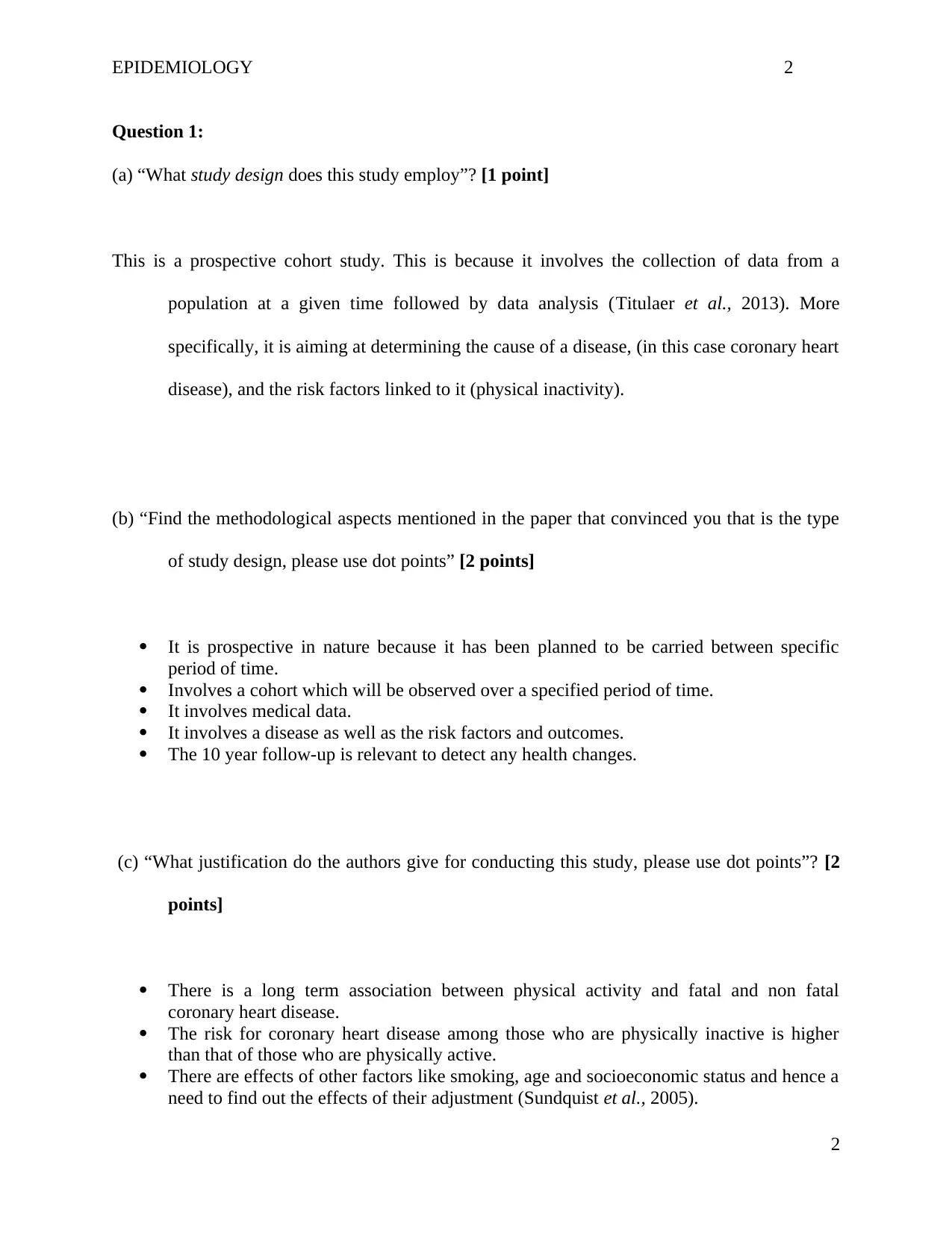
EPIDEMIOLOGY 2
Question 1:
(a) “What study design does this study employ”? [1 point]
This is a prospective cohort study. This is because it involves the collection of data from a
population at a given time followed by data analysis (Titulaer et al., 2013). More
specifically, it is aiming at determining the cause of a disease, (in this case coronary heart
disease), and the risk factors linked to it (physical inactivity).
(b) “Find the methodological aspects mentioned in the paper that convinced you that is the type
of study design, please use dot points” [2 points]
It is prospective in nature because it has been planned to be carried between specific
period of time.
Involves a cohort which will be observed over a specified period of time.
It involves medical data.
It involves a disease as well as the risk factors and outcomes.
The 10 year follow-up is relevant to detect any health changes.
(c) “What justification do the authors give for conducting this study, please use dot points”? [2
points]
There is a long term association between physical activity and fatal and non fatal
coronary heart disease.
The risk for coronary heart disease among those who are physically inactive is higher
than that of those who are physically active.
There are effects of other factors like smoking, age and socioeconomic status and hence a
need to find out the effects of their adjustment (Sundquist et al., 2005).
2
Question 1:
(a) “What study design does this study employ”? [1 point]
This is a prospective cohort study. This is because it involves the collection of data from a
population at a given time followed by data analysis (Titulaer et al., 2013). More
specifically, it is aiming at determining the cause of a disease, (in this case coronary heart
disease), and the risk factors linked to it (physical inactivity).
(b) “Find the methodological aspects mentioned in the paper that convinced you that is the type
of study design, please use dot points” [2 points]
It is prospective in nature because it has been planned to be carried between specific
period of time.
Involves a cohort which will be observed over a specified period of time.
It involves medical data.
It involves a disease as well as the risk factors and outcomes.
The 10 year follow-up is relevant to detect any health changes.
(c) “What justification do the authors give for conducting this study, please use dot points”? [2
points]
There is a long term association between physical activity and fatal and non fatal
coronary heart disease.
The risk for coronary heart disease among those who are physically inactive is higher
than that of those who are physically active.
There are effects of other factors like smoking, age and socioeconomic status and hence a
need to find out the effects of their adjustment (Sundquist et al., 2005).
2

EPIDEMIOLOGY 3
(d) “What was the proportion of those who (i) do not do any physical activity (ii) engaged in
twice a week vigorous physical activity”? (You are not required to report 95%
confidence intervals) [2 points]
No physical activity= 9 %
Twice a week vigorous activity= 10.9%
(e) “What is the crude incidence rate of CHD in inactive men and inactive women”? [2 points]
Inactive men- 111 per 10,000 person-years
Inactive women- 38 per 10,000 person-years
(f) “What is the crude relative risk of being non-active versus being “highly active” (vigorous
physical activity at least twice a week) in men and in women” [2 points]
Non active men= 111
Active men= 61
Non active women= 38
Active women= 14
3
(d) “What was the proportion of those who (i) do not do any physical activity (ii) engaged in
twice a week vigorous physical activity”? (You are not required to report 95%
confidence intervals) [2 points]
No physical activity= 9 %
Twice a week vigorous activity= 10.9%
(e) “What is the crude incidence rate of CHD in inactive men and inactive women”? [2 points]
Inactive men- 111 per 10,000 person-years
Inactive women- 38 per 10,000 person-years
(f) “What is the crude relative risk of being non-active versus being “highly active” (vigorous
physical activity at least twice a week) in men and in women” [2 points]
Non active men= 111
Active men= 61
Non active women= 38
Active women= 14
3
⊘ This is a preview!⊘
Do you want full access?
Subscribe today to unlock all pages.

Trusted by 1+ million students worldwide
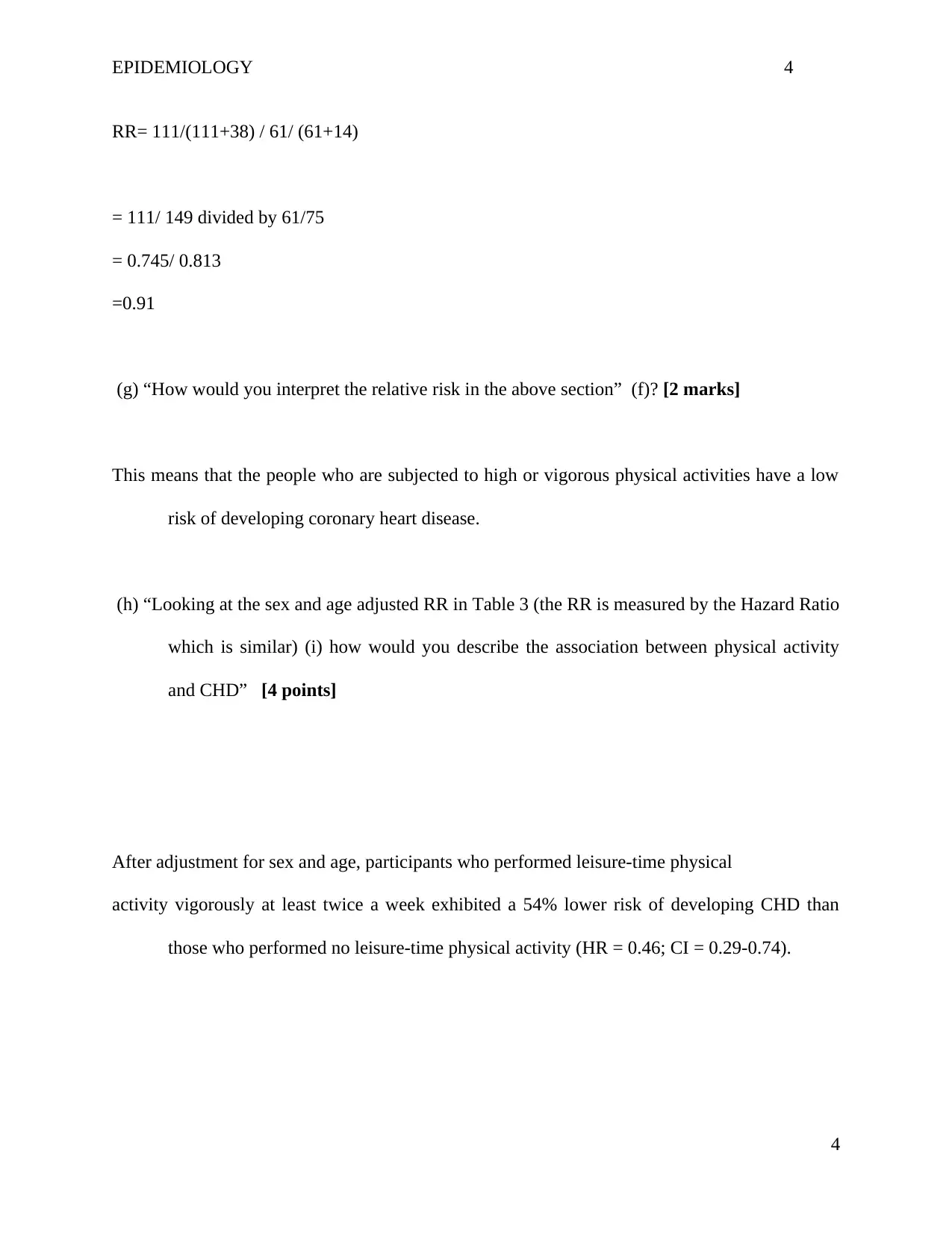
EPIDEMIOLOGY 4
RR= 111/(111+38) / 61/ (61+14)
= 111/ 149 divided by 61/75
= 0.745/ 0.813
=0.91
(g) “How would you interpret the relative risk in the above section” (f)? [2 marks]
This means that the people who are subjected to high or vigorous physical activities have a low
risk of developing coronary heart disease.
(h) “Looking at the sex and age adjusted RR in Table 3 (the RR is measured by the Hazard Ratio
which is similar) (i) how would you describe the association between physical activity
and CHD” [4 points]
After adjustment for sex and age, participants who performed leisure-time physical
activity vigorously at least twice a week exhibited a 54% lower risk of developing CHD than
those who performed no leisure-time physical activity (HR = 0.46; CI = 0.29-0.74).
4
RR= 111/(111+38) / 61/ (61+14)
= 111/ 149 divided by 61/75
= 0.745/ 0.813
=0.91
(g) “How would you interpret the relative risk in the above section” (f)? [2 marks]
This means that the people who are subjected to high or vigorous physical activities have a low
risk of developing coronary heart disease.
(h) “Looking at the sex and age adjusted RR in Table 3 (the RR is measured by the Hazard Ratio
which is similar) (i) how would you describe the association between physical activity
and CHD” [4 points]
After adjustment for sex and age, participants who performed leisure-time physical
activity vigorously at least twice a week exhibited a 54% lower risk of developing CHD than
those who performed no leisure-time physical activity (HR = 0.46; CI = 0.29-0.74).
4
Paraphrase This Document
Need a fresh take? Get an instant paraphrase of this document with our AI Paraphraser
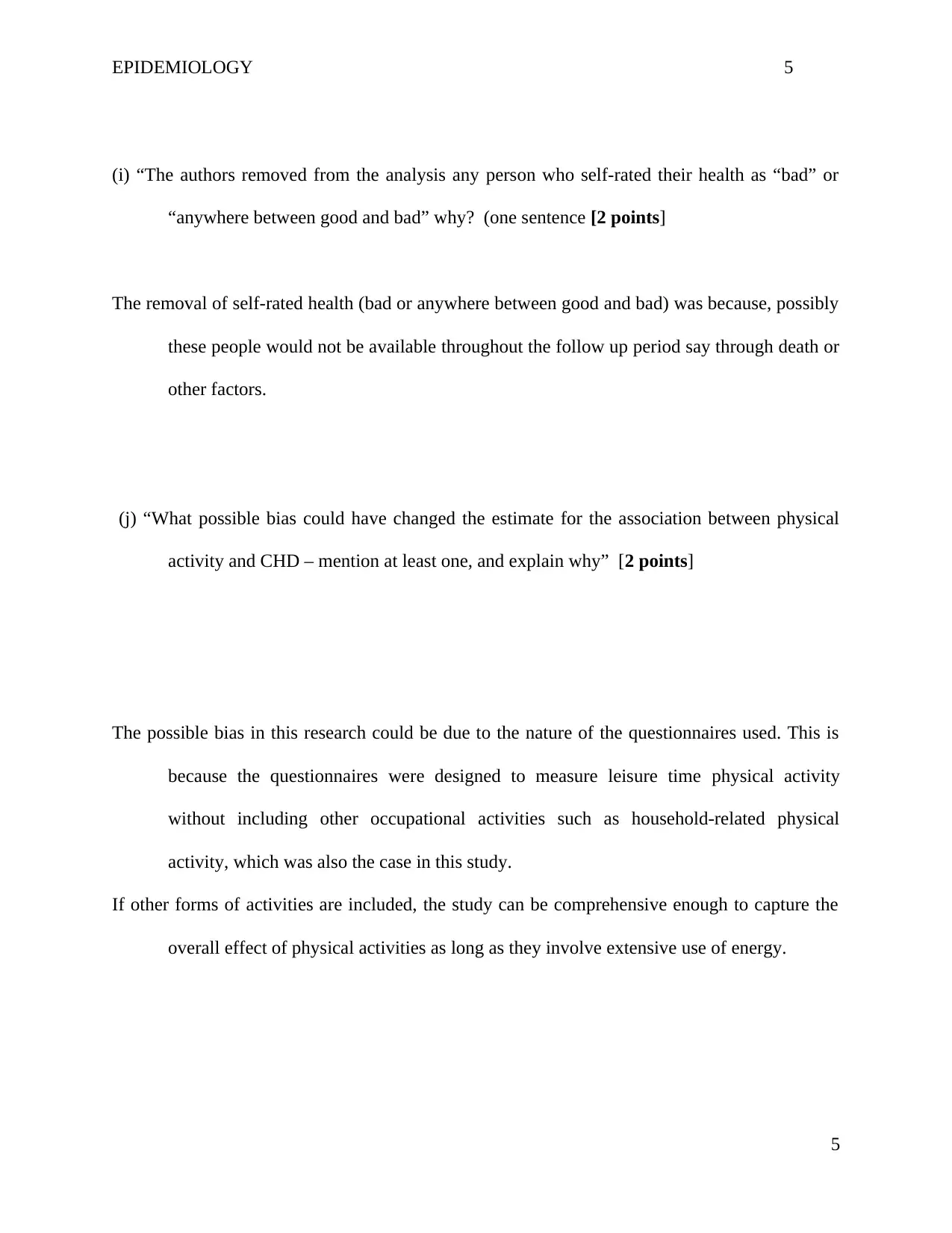
EPIDEMIOLOGY 5
(i) “The authors removed from the analysis any person who self-rated their health as “bad” or
“anywhere between good and bad” why? (one sentence [2 points]
The removal of self-rated health (bad or anywhere between good and bad) was because, possibly
these people would not be available throughout the follow up period say through death or
other factors.
(j) “What possible bias could have changed the estimate for the association between physical
activity and CHD – mention at least one, and explain why” [2 points]
The possible bias in this research could be due to the nature of the questionnaires used. This is
because the questionnaires were designed to measure leisure time physical activity
without including other occupational activities such as household-related physical
activity, which was also the case in this study.
If other forms of activities are included, the study can be comprehensive enough to capture the
overall effect of physical activities as long as they involve extensive use of energy.
5
(i) “The authors removed from the analysis any person who self-rated their health as “bad” or
“anywhere between good and bad” why? (one sentence [2 points]
The removal of self-rated health (bad or anywhere between good and bad) was because, possibly
these people would not be available throughout the follow up period say through death or
other factors.
(j) “What possible bias could have changed the estimate for the association between physical
activity and CHD – mention at least one, and explain why” [2 points]
The possible bias in this research could be due to the nature of the questionnaires used. This is
because the questionnaires were designed to measure leisure time physical activity
without including other occupational activities such as household-related physical
activity, which was also the case in this study.
If other forms of activities are included, the study can be comprehensive enough to capture the
overall effect of physical activities as long as they involve extensive use of energy.
5
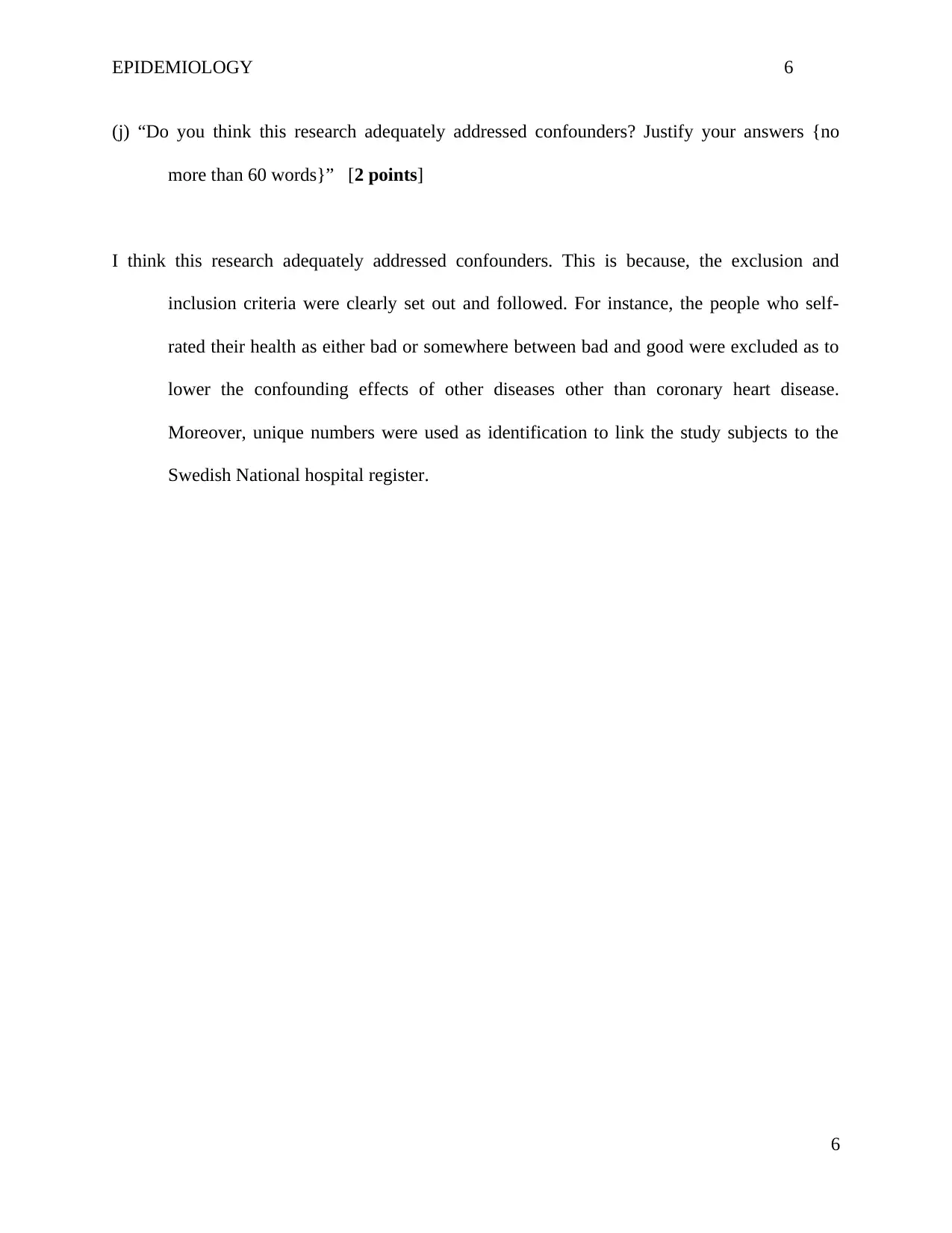
EPIDEMIOLOGY 6
(j) “Do you think this research adequately addressed confounders? Justify your answers {no
more than 60 words}” [2 points]
I think this research adequately addressed confounders. This is because, the exclusion and
inclusion criteria were clearly set out and followed. For instance, the people who self-
rated their health as either bad or somewhere between bad and good were excluded as to
lower the confounding effects of other diseases other than coronary heart disease.
Moreover, unique numbers were used as identification to link the study subjects to the
Swedish National hospital register.
6
(j) “Do you think this research adequately addressed confounders? Justify your answers {no
more than 60 words}” [2 points]
I think this research adequately addressed confounders. This is because, the exclusion and
inclusion criteria were clearly set out and followed. For instance, the people who self-
rated their health as either bad or somewhere between bad and good were excluded as to
lower the confounding effects of other diseases other than coronary heart disease.
Moreover, unique numbers were used as identification to link the study subjects to the
Swedish National hospital register.
6
⊘ This is a preview!⊘
Do you want full access?
Subscribe today to unlock all pages.

Trusted by 1+ million students worldwide
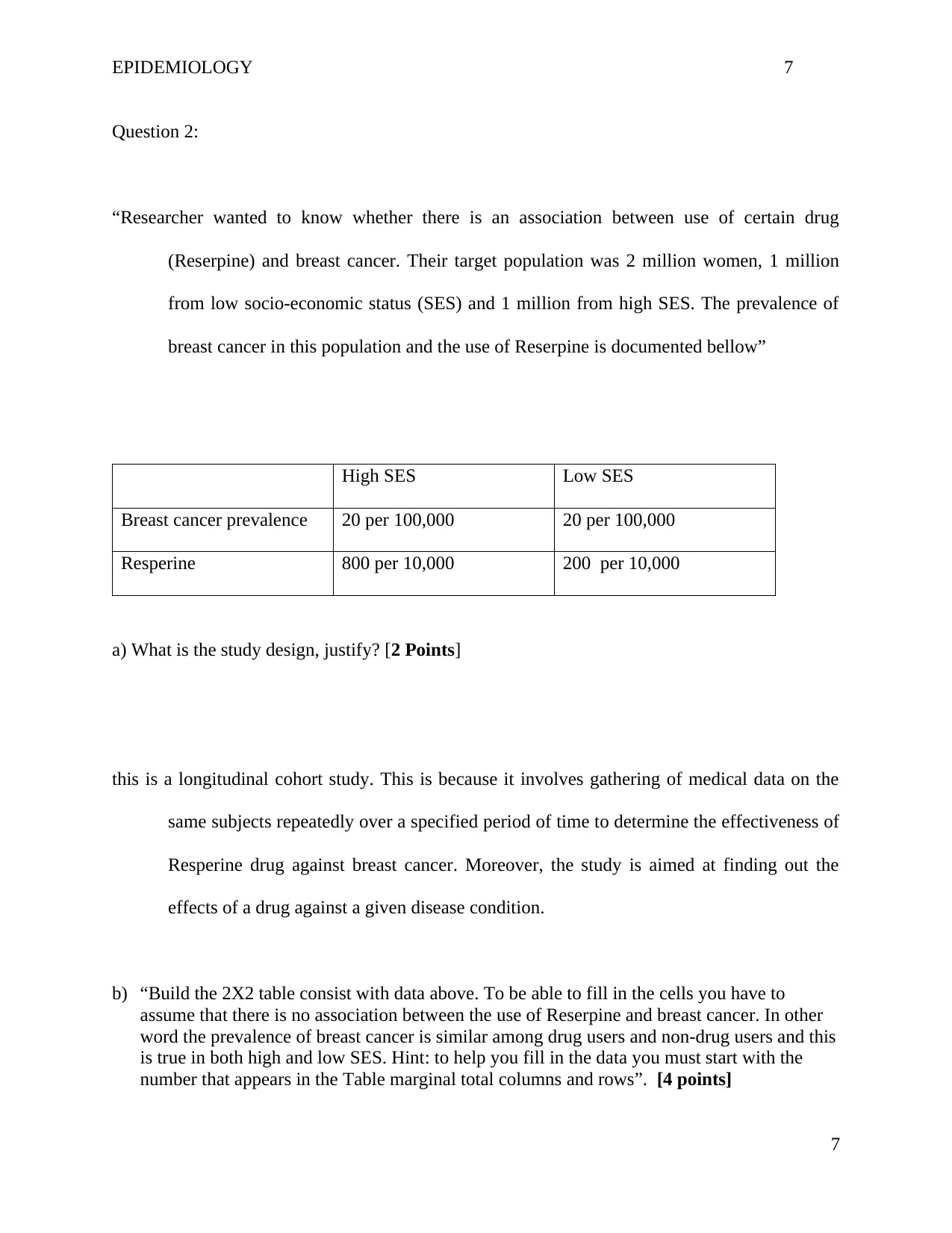
EPIDEMIOLOGY 7
Question 2:
“Researcher wanted to know whether there is an association between use of certain drug
(Reserpine) and breast cancer. Their target population was 2 million women, 1 million
from low socio-economic status (SES) and 1 million from high SES. The prevalence of
breast cancer in this population and the use of Reserpine is documented bellow”
High SES Low SES
Breast cancer prevalence 20 per 100,000 20 per 100,000
Resperine 800 per 10,000 200 per 10,000
a) What is the study design, justify? [2 Points]
this is a longitudinal cohort study. This is because it involves gathering of medical data on the
same subjects repeatedly over a specified period of time to determine the effectiveness of
Resperine drug against breast cancer. Moreover, the study is aimed at finding out the
effects of a drug against a given disease condition.
b) “Build the 2X2 table consist with data above. To be able to fill in the cells you have to
assume that there is no association between the use of Reserpine and breast cancer. In other
word the prevalence of breast cancer is similar among drug users and non-drug users and this
is true in both high and low SES. Hint: to help you fill in the data you must start with the
number that appears in the Table marginal total columns and rows”. [4 points]
7
Question 2:
“Researcher wanted to know whether there is an association between use of certain drug
(Reserpine) and breast cancer. Their target population was 2 million women, 1 million
from low socio-economic status (SES) and 1 million from high SES. The prevalence of
breast cancer in this population and the use of Reserpine is documented bellow”
High SES Low SES
Breast cancer prevalence 20 per 100,000 20 per 100,000
Resperine 800 per 10,000 200 per 10,000
a) What is the study design, justify? [2 Points]
this is a longitudinal cohort study. This is because it involves gathering of medical data on the
same subjects repeatedly over a specified period of time to determine the effectiveness of
Resperine drug against breast cancer. Moreover, the study is aimed at finding out the
effects of a drug against a given disease condition.
b) “Build the 2X2 table consist with data above. To be able to fill in the cells you have to
assume that there is no association between the use of Reserpine and breast cancer. In other
word the prevalence of breast cancer is similar among drug users and non-drug users and this
is true in both high and low SES. Hint: to help you fill in the data you must start with the
number that appears in the Table marginal total columns and rows”. [4 points]
7
Paraphrase This Document
Need a fresh take? Get an instant paraphrase of this document with our AI Paraphraser
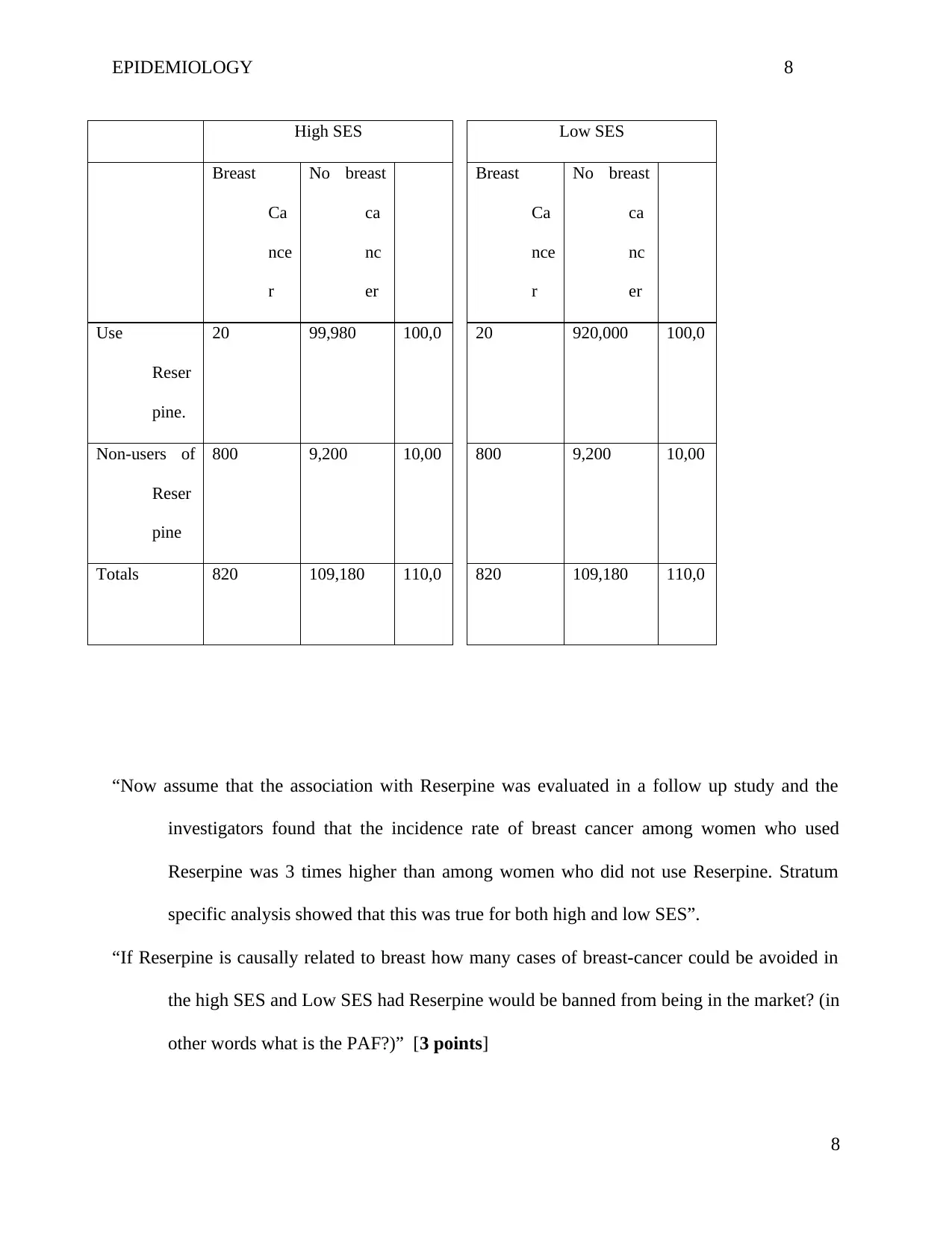
EPIDEMIOLOGY 8
High SES Low SES
Breast
Ca
nce
r
No breast
ca
nc
er
Breast
Ca
nce
r
No breast
ca
nc
er
Use
Reser
pine.
20 99,980 100,0 20 920,000 100,0
Non-users of
Reser
pine
800 9,200 10,00 800 9,200 10,00
Totals 820 109,180 110,0 820 109,180 110,0
“Now assume that the association with Reserpine was evaluated in a follow up study and the
investigators found that the incidence rate of breast cancer among women who used
Reserpine was 3 times higher than among women who did not use Reserpine. Stratum
specific analysis showed that this was true for both high and low SES”.
“If Reserpine is causally related to breast how many cases of breast-cancer could be avoided in
the high SES and Low SES had Reserpine would be banned from being in the market? (in
other words what is the PAF?)” [3 points]
8
High SES Low SES
Breast
Ca
nce
r
No breast
ca
nc
er
Breast
Ca
nce
r
No breast
ca
nc
er
Use
Reser
pine.
20 99,980 100,0 20 920,000 100,0
Non-users of
Reser
pine
800 9,200 10,00 800 9,200 10,00
Totals 820 109,180 110,0 820 109,180 110,0
“Now assume that the association with Reserpine was evaluated in a follow up study and the
investigators found that the incidence rate of breast cancer among women who used
Reserpine was 3 times higher than among women who did not use Reserpine. Stratum
specific analysis showed that this was true for both high and low SES”.
“If Reserpine is causally related to breast how many cases of breast-cancer could be avoided in
the high SES and Low SES had Reserpine would be banned from being in the market? (in
other words what is the PAF?)” [3 points]
8
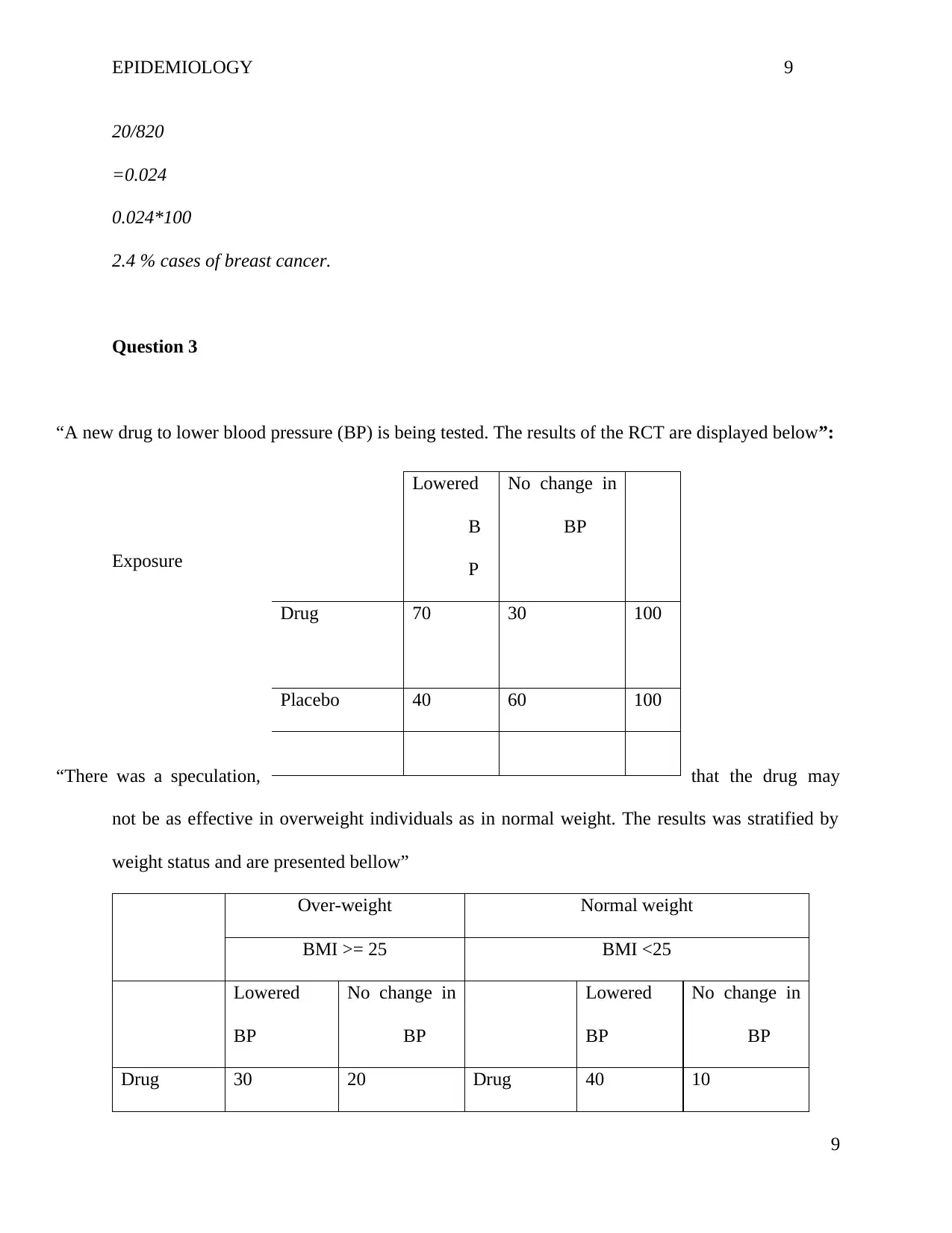
EPIDEMIOLOGY 9
20/820
=0.024
0.024*100
2.4 % cases of breast cancer.
Question 3
“A new drug to lower blood pressure (BP) is being tested. The results of the RCT are displayed below”:
Exposure
“There was a speculation, that the drug may
not be as effective in overweight individuals as in normal weight. The results was stratified by
weight status and are presented bellow”
Over-weight Normal weight
BMI >= 25 BMI <25
Lowered
BP
No change in
BP
Lowered
BP
No change in
BP
Drug 30 20 Drug 40 10
9
Lowered
B
P
No change in
BP
Drug 70 30 100
Placebo 40 60 100
20/820
=0.024
0.024*100
2.4 % cases of breast cancer.
Question 3
“A new drug to lower blood pressure (BP) is being tested. The results of the RCT are displayed below”:
Exposure
“There was a speculation, that the drug may
not be as effective in overweight individuals as in normal weight. The results was stratified by
weight status and are presented bellow”
Over-weight Normal weight
BMI >= 25 BMI <25
Lowered
BP
No change in
BP
Lowered
BP
No change in
BP
Drug 30 20 Drug 40 10
9
Lowered
B
P
No change in
BP
Drug 70 30 100
Placebo 40 60 100
⊘ This is a preview!⊘
Do you want full access?
Subscribe today to unlock all pages.

Trusted by 1+ million students worldwide

EPIDEMIOLOGY 10
Placebo 20 30 Placebo 20 30
a) “Calculate the crude measure of association between the drug and blood pressure [2
points]”
70/ 100 divided by 40/100
0.7/ 0.4
=1.75
b) “Calculate the stratum specific association between the drug and blood pressure [2
points]”
Overweight = 30/50 divided by 20/50
0.6 / 0.4
= 1.5
Normal weight= 40/50 divided by 20/50
= 0.8/ 0.4
=2
10
Placebo 20 30 Placebo 20 30
a) “Calculate the crude measure of association between the drug and blood pressure [2
points]”
70/ 100 divided by 40/100
0.7/ 0.4
=1.75
b) “Calculate the stratum specific association between the drug and blood pressure [2
points]”
Overweight = 30/50 divided by 20/50
0.6 / 0.4
= 1.5
Normal weight= 40/50 divided by 20/50
= 0.8/ 0.4
=2
10
Paraphrase This Document
Need a fresh take? Get an instant paraphrase of this document with our AI Paraphraser
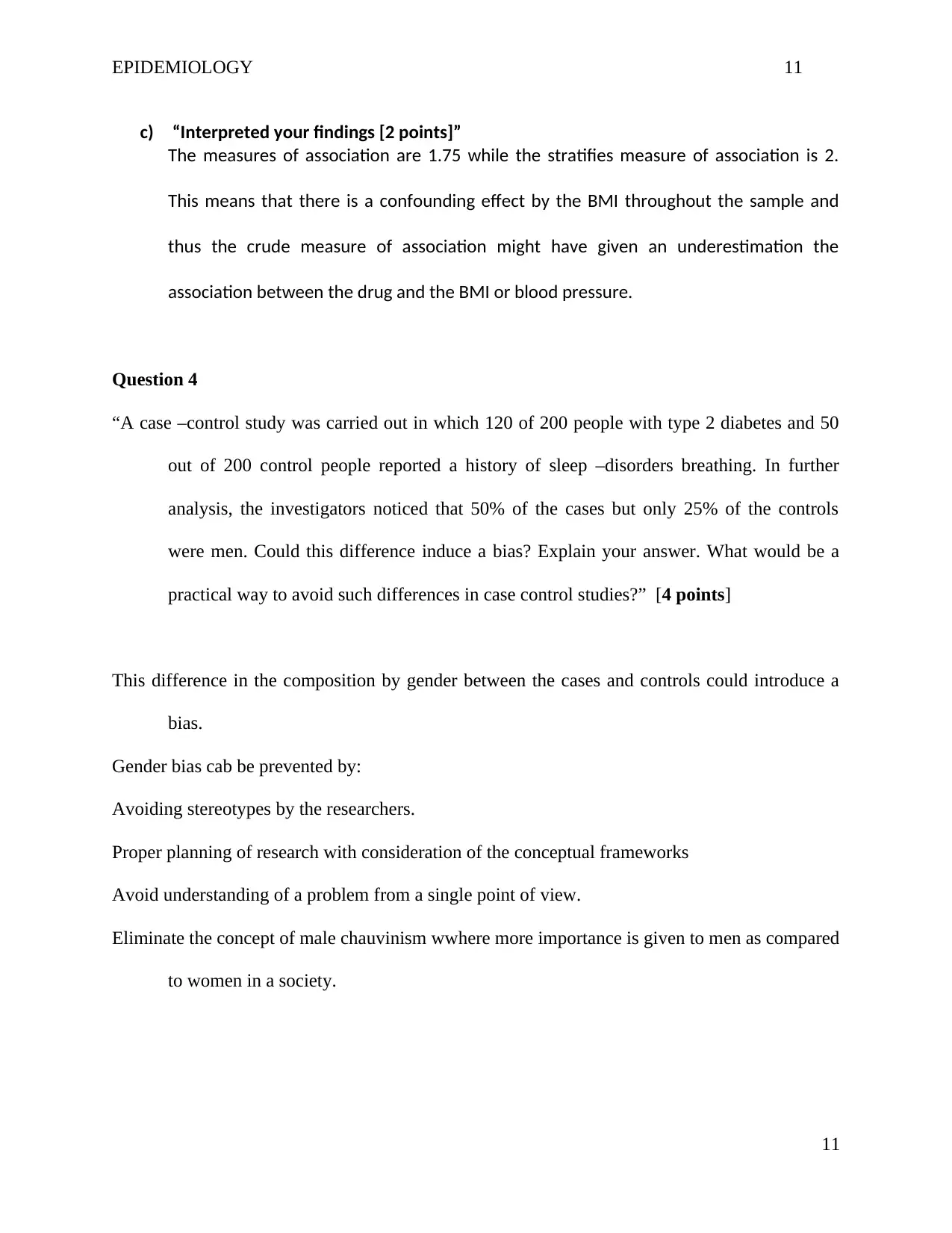
EPIDEMIOLOGY 11
c) “Interpreted your findings [2 points]”
The measures of association are 1.75 while the stratifies measure of association is 2.
This means that there is a confounding effect by the BMI throughout the sample and
thus the crude measure of association might have given an underestimation the
association between the drug and the BMI or blood pressure.
Question 4
“A case –control study was carried out in which 120 of 200 people with type 2 diabetes and 50
out of 200 control people reported a history of sleep –disorders breathing. In further
analysis, the investigators noticed that 50% of the cases but only 25% of the controls
were men. Could this difference induce a bias? Explain your answer. What would be a
practical way to avoid such differences in case control studies?” [4 points]
This difference in the composition by gender between the cases and controls could introduce a
bias.
Gender bias cab be prevented by:
Avoiding stereotypes by the researchers.
Proper planning of research with consideration of the conceptual frameworks
Avoid understanding of a problem from a single point of view.
Eliminate the concept of male chauvinism wwhere more importance is given to men as compared
to women in a society.
11
c) “Interpreted your findings [2 points]”
The measures of association are 1.75 while the stratifies measure of association is 2.
This means that there is a confounding effect by the BMI throughout the sample and
thus the crude measure of association might have given an underestimation the
association between the drug and the BMI or blood pressure.
Question 4
“A case –control study was carried out in which 120 of 200 people with type 2 diabetes and 50
out of 200 control people reported a history of sleep –disorders breathing. In further
analysis, the investigators noticed that 50% of the cases but only 25% of the controls
were men. Could this difference induce a bias? Explain your answer. What would be a
practical way to avoid such differences in case control studies?” [4 points]
This difference in the composition by gender between the cases and controls could introduce a
bias.
Gender bias cab be prevented by:
Avoiding stereotypes by the researchers.
Proper planning of research with consideration of the conceptual frameworks
Avoid understanding of a problem from a single point of view.
Eliminate the concept of male chauvinism wwhere more importance is given to men as compared
to women in a society.
11
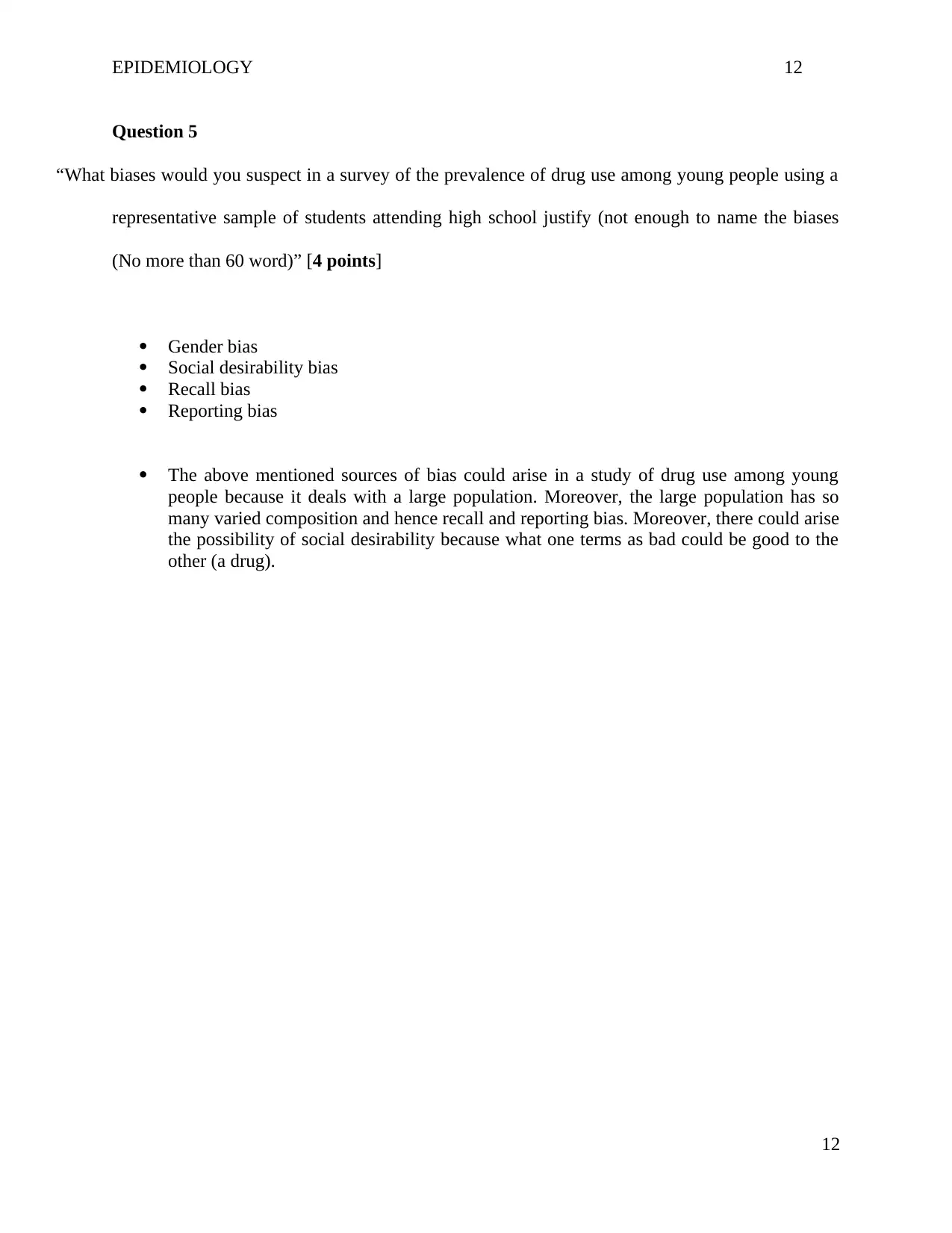
EPIDEMIOLOGY 12
Question 5
“What biases would you suspect in a survey of the prevalence of drug use among young people using a
representative sample of students attending high school justify (not enough to name the biases
(No more than 60 word)” [4 points]
Gender bias
Social desirability bias
Recall bias
Reporting bias
The above mentioned sources of bias could arise in a study of drug use among young
people because it deals with a large population. Moreover, the large population has so
many varied composition and hence recall and reporting bias. Moreover, there could arise
the possibility of social desirability because what one terms as bad could be good to the
other (a drug).
12
Question 5
“What biases would you suspect in a survey of the prevalence of drug use among young people using a
representative sample of students attending high school justify (not enough to name the biases
(No more than 60 word)” [4 points]
Gender bias
Social desirability bias
Recall bias
Reporting bias
The above mentioned sources of bias could arise in a study of drug use among young
people because it deals with a large population. Moreover, the large population has so
many varied composition and hence recall and reporting bias. Moreover, there could arise
the possibility of social desirability because what one terms as bad could be good to the
other (a drug).
12
⊘ This is a preview!⊘
Do you want full access?
Subscribe today to unlock all pages.

Trusted by 1+ million students worldwide
1 out of 12
Related Documents
Your All-in-One AI-Powered Toolkit for Academic Success.
+13062052269
info@desklib.com
Available 24*7 on WhatsApp / Email
![[object Object]](/_next/static/media/star-bottom.7253800d.svg)
Unlock your academic potential
© 2024 | Zucol Services PVT LTD | All rights reserved.



